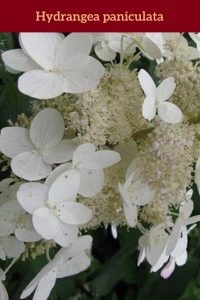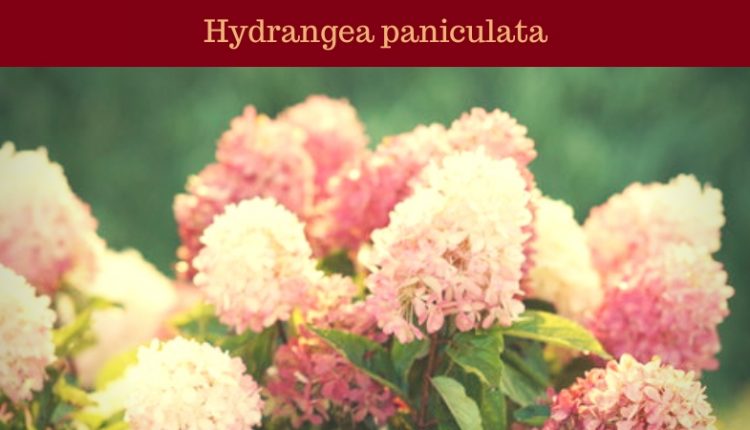Introduction of new panicled hydrangea varieties also launches new garden forms that command nontraditional uses. Landscape gardeners can find varieties (cultivars) to suit almost any landscaping need from container plantings to shrub borders to focal or accent groupings. Many introductions within the last few decades are from Jelena and Robert deBelder’s Kalmthout Arboretum, Belgium and plant breeders in the Netherlands.
Hydrangea paniculata ‘Grandiflora,’ introduced to western garden landscapes in the mid-19th century from eastern Asia, is one of seven Hydrangea species suitable and adaptable to North America. Until recently, most nurseries sold only the tree form of ‘Grandiflora’ nicknamed PeeGee, probably named from paniculata ‘Grandiflora’ or P. G.
 Old New England cemeteries and traditional landscapes provide numbers of solitary and neglected PeeGee hydrangeas. They produce pyramidal-shaped flower panicles – 6 to 8-inches long and wider at the base than tip – that are prized autumn features. The florets, most fertile and not showy but with a lesser amount sterile and showy, change color from yellow-white to pink as they mature. Dried panicles of these pink florets brighten many autumn flower arrangements.
Old New England cemeteries and traditional landscapes provide numbers of solitary and neglected PeeGee hydrangeas. They produce pyramidal-shaped flower panicles – 6 to 8-inches long and wider at the base than tip – that are prized autumn features. The florets, most fertile and not showy but with a lesser amount sterile and showy, change color from yellow-white to pink as they mature. Dried panicles of these pink florets brighten many autumn flower arrangements.
Characteristics of Hydrangea paniculata
- Cold hardy from plant growing zones 3 to 8;
- Set buds and bloom on current year’s wood;
- Bloom from mid-July to September or later;
- Color not dependent upon soil acidity;
- Full sun plant, but will grow and bloom in partial shade;
- Thrives in rich, porous moist and well-drained soil; however
- Adaptable, and tolerant of urban conditions – difficult to destroy.
Selected Cultivars
A tally of online and print sources shows upward of 24 panicled hydrangea cultivars. Regional and local retail nurseries are slowly purchasing and featuring the most unusual of these cultivars.
Landscape gardeners who want to introduce new form and color into late summer and autumn landscapes should survey which panicled hydrangea cultivars are available to them. The next step is deciding exactly how to use the cultivars. Below are three cultivars that demonstrate a variety of uses in the modern landscape:
- ‘Quick Fire’ begins bloom in the mid-Atlantic states from late June to early July. Blooms change from white to a rich pink-red. Autumn leaf color is green with a tinge of yellow, sometimes a red-purple. Mature size is 6-to-8 feet tall, 3-to-5 feet wide. This cultivar serves a variety of uses: specimens or massed as accents, perennial or shrub borders, screens or hedges, mixed container plantings.
- ‘Limelight’ flowers in mid-summer with chartreuse or yellow-white florets that become pink to burgundy with cool autumn temperatures. Summer and autumn leaf color is light green with some reports of red autumn foliage. Mature size is 6-to-8 feet tall, but spreads 5-to-7 feet wide. This cultivar, like ‘Quick Fire,’ also serves a variety of uses. However, rigorous pruning of ‘Limelight’ is necessary to keep it contained in small landscape displays.
- ‘Pinky Winky,’, produces 12- to-16 inch long flower panicles on strong red stems. The upright stems prevent the drooping panicles seen on the Pee Gee hydrangea. New florets emerge white while the older ones turn dark pink. The result is a panicle of two-toned florets. Panicles bloom and grow until frost. ‘Pinky Winky’ matures to 8 feet tall and equally as wide This cultivar is best used as specimens or massed as accents, perennial or shrub borders, screens or hedges.



Comments are closed, but trackbacks and pingbacks are open.